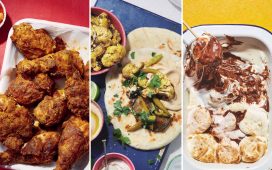SAN ANTONIO — Austin Wondzell’s midnight blue S.U.V. was one of the nearly 2,000 vehicles winding through a stadium parking lot on a Friday morning in mid-May.
Like millions of Americans, he turned to a food bank for help when he lost his job. “I can’t believe there are so many people that need food,” he said, as he inched closer to the San Antonio Food Bank’s second mega-distribution of the week.
Since the coronavirus pandemic began, food bank lines stretching for miles and jam-packed parking lots across the United States have come to symbolize a new food security crisis set off by sudden and unprecedented job losses. While states have begun to loosen restrictions, surges in new cases will likely keep people home, out of work and in need of assistance.
Surveys conducted amid the pandemic by the National Institute for Health Care Management Foundation found “38 percent of households reported moderate to high levels of food insecurity,” compared with 11 percent of households in 2018. Food banks nationwide have reported increased demand.
For the San Antonio Food Bank, which serves 16 counties in Southwest Texas, demand has doubled. Before the pandemic, they were feeding approximately 60,000 people per week. That number is now closer to 120,000.
In March, April and May, the food bank reported distributing over 23.3 million pounds of food, serving over 240,000 cars at drive-through distributions and completing over 5,800 home deliveries.
To meet the demand, the food bank has organized twice-weekly mega-distributions, where up to 2,000 vehicles receive two weeks’ worth of food. They are also carrying out and supporting smaller-scale distributions at locations across southwest Texas. In May alone, 27,595 vehicles were served during mega distributions in Bexar County, home to San Antonio.
At the city’s mega-distribution sites, dozens of volunteers, clad in gray “San Antonio Strong,” T-shirts, colorful masks and disposable blue gloves are fanned out across a stadium parking lot temporarily filled with tents and pallets of food.
Starting at 9 a.m., drivers, some of whom have been waiting since dawn, are guided down lanes to different stations, where items like bread, squash, apples, bacon and more, are packed into trunks, truck beds and back seats with assembly-line efficiency.
From above the crowded parking lot, the vehicles look like a statistic. But behind every wheel is an individual with his or her own experience navigating the pandemic-imposed challenges and a reason for getting in line. These are some of their stories.
Over the years, Rudy Riojas, 66, has traveled across the United States in his minivan, often folding down the seats and sleeping on a mattress in the back. At 11 p.m. on a Thursday night, after helping his fiancée with her small commercial cleaning business, the couple closed their eyes in the van, this time in front of the Alamodome, where the San Antonio Food Bank would hold another mega-distribution the next morning. They were second in line.
“San Antonio is going out of their way to hand out food for people,” Mr. Riojas said. “That’s one of the most beautiful things that can happen.”
Mr. Riojas is retired and receives Social Security benefits. Before the pandemic, his fiancée’s business had nine clients, now it has one. “That’s enough to get us through,” he said, adding that the government stimulus check helped. “We’re not on top of the world. But we’re OK, we’re surviving.”
Marissa Hopper, 24, waited in line with her three children. She has been working part time at a pizza restaurant while finishing her college degree. She wants to teach math to elementary and middle schoolers.
Ms. Hopper’s hours at the restaurant were cut, and her husband, who works in construction, spent two weeks in quarantine after believing he may have been exposed to Covid-19, leaving them with little income. Before the pandemic, Ms. Hopper had not been to a food bank since she was a high school senior, when her first daughter was born.
“I wanted to never have to go back, just because I wanted to be able to prove like, yeah, I was a teen mom but I learned from this, I grew and I didn’t need the help,” she said. “But everyone needs help at some point.”
Lucy Hernandez, 50, struggles with mental health challenges and makes ends meet with disability benefits. “I have a lot of bills,” she said, “so that’s one of the reasons that I come to the food bank. It saves me.”
Sabrina Ainsworth, 47, a home care provider, has continued working through the pandemic. But her husband, who moves mobile homes, was temporarily out of work. She supplemented their store-bought groceries with those distributed by the food bank.
“At first, I kind of didn’t like it, I was embarrassed. But when I see a lot of people that I know that are there, you’re like, ‘Hey, what’s going on,’ and stuff and I’m OK with it. It just sucks.”
Kyle Kuberski, 65, grew up in San Antonio and spent 25 years in Florida working in construction management before returning to help with his family real estate business. He was compelled to volunteer for the food bank in April after seeing news coverage of the thousands of cars lined up to receive food donations in a stadium parking lot.
“I’ve cleaned up after a dozen hurricanes and this is what you do,” Mr. Kuberski said. “When your friends and neighbors are in trouble, you find out a way to help them.”
Eric Cooper became C.E.O. of the San Antonio Food Bank in 2001, at age 32.
With the support of the State of Texas, the San Antonio community, food bank employees, an army of volunteers and more, Mr. Cooper has steered the food bank through the Covid-19 crisis.
After a recent mega-distribution, “worn out and tired,” and still wearing his food bank shirt, Mr. Cooper went shopping for groceries of his own.
As he pushed his cart down an aisle, several families noticed his shirt, turned to him, started clapping and gave what he described as “a standing ovation in the middle of a grocery store.”
Moments like these, he said, have offered “tender mercies” amid the crisis.
Anita and Kevin Bell last went to a food bank in Detroit, in the wake of the Great Recession. Nearly 12 years later, the Bells, who have been married for 23 years, once again turned to a food bank.
Ms. Bell works at a San Antonio hospital and recently transitioned from being a certified nursing assistant to a more administrative role because of a knee injury.
Despite her fear of catching the virus, she worked right up until undergoing surgery in mid-May, citing a simple equation: “Either put that mask on and go out and work, or be homeless and have no money,” she said.
Mr. Bell, a truck driver, has been making fewer deliveries and Ms. Bell is receiving 60 percent of her income while she recovers. With two disabled children at home, the Bell family is adapting.
Ms. Bell is making sure nothing she receives goes to waste. She shares food with her neighbor and has been canning the leftover apples, using a time-tested recipe passed on by her grandmother, who lived through the Great Depression, to use as pie filling or with biscuits.
Francisco Martinez, 40, was making good money at a San Antonio sand mine that serves the oil and gas industry. He was considered an essential worker, but was furloughed after the pandemic dampened demand for fossil fuels.
Mr. Martinez used a recent trip to the food bank as a teachable moment for his teenage son and daughters: “I’m just trying to show them that it ain’t bad to ask for help,” he said.
Yolanda Calderon, 54, never had trouble sleeping. Now, waves of bad news, the fear of getting sick and the new reality of living paycheck to paycheck have kept her up at night. Ms. Calderon stopped working late last year, when dealing with a cancer scare became her priority. Her partner, who worked at an auto body shop until Texas shut down in March, went on unemployment — their only source of income. “It’s hard. We have a mortgage, we have our bills, our food,” Ms. Calderon said. “Thank God they do have the food banks and stuff, because we can’t make it.”
Ms. Calderon is taking the pandemic in stride. She took up landscaping and planted daisies, elephant ears, petunias and native wildflowers in her front yard. Winter vegetables in the backyard are next.
She has also started using the apples she receives from the food bank to bake pies for her neighbors. “If they were to give me lemons, I would have made lemonade,” she said.
After 30 years as an apprentice installing plumbing systems for new homes, Raymond Grady, 53, was an exam away from finally getting his tradesman plumber license.
The exam, scheduled for mid-April, came at a necessary time — he lost his plumbing job in January and found another company that would hire him if he passed the test. When the exam was canceled because of the pandemic, Mr. Grady had no work and no Plan B.
He spent his stimulus check on bills and, on a Monday in mid-May, woke up at 4 a.m. to line up for his fourth trip to the food bank with his wife, son and dog, Blue.
“We’re struggling like big dogs,” he said. “There’s been a couple of times already I’ve thought about taking all my tools and selling all my tools just so I can make it through the week.”
But, despite the setbacks, Mr. Grady believes he will make it “one way or another,” and said he sees a silver lining: He lost 10 pounds thanks to a healthier diet and is spending more quality time with his wife of 28 years.
Sherine Taylor, 58, is a disabled Navy veteran who works part time for Southwest Airlines. Ms. Taylor has made numerous visits to the food banks, often with her sister behind her in another vehicle, to provide for their family, some of whom are at a high risk for the virus.
“I’m a true believer that you can’t expect somebody to do something for you if you’re not willing to do something for yourself,” she said. “It’s good to know that people do care.”
Shannon Bonwright, 55, has been on the giving and receiving ends of food bank lines at different times in her life, but after driving through her first distribution of the pandemic, she pulled over and cried.
“I was amazed and so grateful the whole way through at all of the police officers and all the people volunteering and just thought wow, you can feel the love,” said Ms. Bonwright, an artist who has been living with her mother while she recovers from knee-replacement surgery.
She received so much food that, after filling her refrigerator, she spent the afternoon dividing what was left to share with four other households.
Elizabeth Wells and Mary Thomas, both 57, pulled up to the food bank line at 3:30 a.m. They wanted to get through their second distribution quickly once it started at 9, and enjoy the “good fellowship” of waiting together.
For Ms. Wells, a retired hairdresser and church missionary, the distributions are becoming an opportunity for her to help members of her community.
When she returned home, she prepared four boxes that would be split among eight families, which included her out-of-work neighbor with three children, her pastor, a woman at her church, and a person with multiple sclerosis.
“It ain’t just a black thing, it ain’t just a white thing. It’s a human race thing. Everybody is in this together,” Ms. Wells said. “You’re seeing so much love that you’ve never seen before in your life and what I hope is that after all this is over with, that same amount of love just stays.”
Jack Armstrong and JoAnne Williams, both 65, depend on Social Security. The food bank, Ms. Williams said, has been “very, very stress relieving. It feeds two families.”
Ms. Williams, who has health issues including diabetes and asthma, feels vulnerable.
“I just wish they wouldn’t have opened up so soon,” she said. “It’s kind of scary, so I just basically stay home. And if I am at the store and it gets crowded, I always tell him: ‘OK, let’s go, let’s get out of here. It’s getting crowded’ — even though we wear masks.”
Five years ago, health issues forced Larry Blosser, 53, to stop working as a utility foreman. Since then, he has gotten by on a mix of disability benefits and income from occasional carpentry and electrical gigs. With fewer “odds-and-end jobs,” Mr. Blosser said that he and his wife, whose hours as a hospital administrative assistant were cut, have been struggling to make ends meet.
For Mr. Blosser, the fear of not being able to provide for his family has been the hardest part of the pandemic. “This isn’t me,” he said, while waiting in line for his second trip to the food bank. “I’ve never asked for help, and it’s just rough.”
And yet, after his first trip, he shared what he received with seven other families in the neighborhood.
Joey Lopez, an 83-year-old retiree, and his wife woke up at 5 a.m. to ensure they were in line early.
“It’s just a matter of time, and [you] have to be patient, very humble and wait until everything turns out better,” Mr. Lopez said.
“We have one thing in our favor: We believe in God,” he said. “He will never leave us without food … Of course we have to put our input also, we have to do something. We just can’t stay home and say, ‘oh, Lord, send it here to the house with the food.’ Come on, we have to get up and do our thing.”
Marie Cardenas, 59, handed out bags of green beans to people passing through the food bank line.
A month and a half earlier, Ms. Cardenas, who recently relocated to Texas from California to help her ailing mother, lost her job and joined the thousands of others in need of assistance for the first time.
“By the time it was my turn to come in, I was in tears and feeling guilty and like I didn’t belong because I had a nice car,” she said.
Ms. Cardenas was so moved by the San Antonio Food Bank’s generosity that, after receiving her unemployment benefits and government stimulus check, she decided to return, but to the other side of the line.
“I like to say that I’m kind of a reminder to some people I hear who judge sometimes who they see in line, and I remind them that it’s not exactly what you see because I was in that line myself,” she said. “We’re all in this together. Doesn’t matter who you are — you could look perfectly stable and not realize that you just have nothing right now. Absolutely nothing.”
Now, as every car passes, Ms. Cardenas echoes what she heard as she made her way through the line: Have a blessed day. “I’ve never used that term in my life,” she said. “I guess it’s a Texas thing.”





